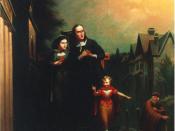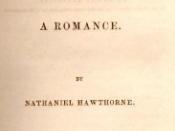Moral Law Vs. Natural Law "At the dramatic center of The Scarlet Letter is the idea of the awesomeness and inescapability of the Moral Law, to which all else is finally submitted,"� (Levy 384).
Assuming that Hawthorne wrote The Scarlet Letter exploring the relationship between Moral law and Natural law, he chooses the moral laws to be absolute. Using definitions of nature and character provided by Seymour Katz applied to the terms natural law and moral law allow an extension of Leo Levy's claim that Moral laws are supreme. Moral law is an internalization of normalizing aspects of society it, "is acquired in time through nurture, education, and social experience. The older the individual the more fixed and stable is his character, and the less likely he is to act outside of the principles of his society or his role,"� (Katz 5). The natural law is being in a condition where society cannot impose any rules or laws, "It is undirected impulse or potential energy which the individual will expend and express in various ways in the course of his life,"� (4).
By applying the definitions of natural law and moral law to the way Hawthorne reveals the truth in the novel and to the development of the character Pearl, Hawthorne proves that moral law is the dominant form of law in The Scarlet Letter.
In the forest natural laws should be supreme. Here, the black man or devil makes his home, Mistress Hibbons goes to perform her witchcraft, and Hester and Dimmesdale commit their adultery (Hawthorne 144-145). Moral law forbids each of these three things. Only in the forest, a place where moral law does not apply, can any of these things happen. From a very early age people are taught by the moral laws that the...


